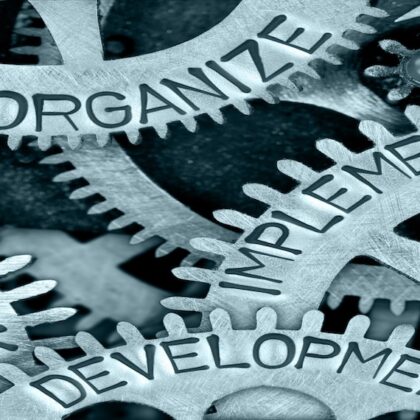* Leadership
Build Your Own Unique Transformation Process
Rapid Results!
Chapter 6
Build Your Own Unique Transformation Process
Of all the CEOs who will be tossing and turning tonight, you can bet that a large number of them are wondering how to carry out some kind of major transformations in their companies: Reversing profit deterioration; adapting to radical marketplace shifts; accelerating slow growth; and quickening the pace of innovation.
An army of consultants and academics have invested major effort in trying to create the right formula for executing these transformations, but without much success. Although some of the models have won many converts and acolytes, none has really demonstrated lasting value.
The weakness of master models was demonstrated by the landmark Harvard Business School study by Michael Beer (et al) mentioned in Chapter 1. After studying a number of attempted major transformations in a variety of corporations, the main conclusion was that company-wide change efforts based on formally structured programs failed to achieve their aims. As Beer and his co-authors colorfully put it, “wave after wave of programs rolled across the landscape with little positive impact”1 By contrast the successful efforts tended to be empirically developed by the companies themselves. And in those companies the change process emanated not from top down, but from bottom up.
Our own observations of many attempted transformations strongly suggest that no universal change template has yet been discovered nor is any waiting to be discovered. While organizations can certainly benefit from the cumulated experience of others, we are convinced that each organization must create a unique change process that works best for itself. In this chapter we will sketch a framework by which management teams can carry out the experimentation and learning necessary to accomplish that process. It is not a change architecture, per se, but rather a framework that enables each organization to construct its own change architecture.
A Radical Departure: Design Each Organization’s Transition Process as a Unique Creative Work
The basic idea we will advance in this chapter is that a major transformational change effort should be divided into a series of discrete staged advances, each about 4 to 6 months long; each focused on a set of agreed-upon overall objectives; and each with a clear beginning and a clear end.
Within each of these stages, a number of planned change steps are carried out. From the beginning, rapid results projects provide much of the energy and drive. And each rapid results project is designed to produce urgently-needed business results that will move the organization toward its transformational goals for that period; but in addition, the project should yield some new managerial capability in implementing change; and some new insights about the corporation’s strategy.
The successes during each stage provide the zest and confidence for moving ahead. And at the end of each phase, the achievements and associated learning are assessed, and the resulting wisdom is exploited in the design of the subsequent period. Thus, the number of projects as well as the scope of each can expand in each successive stage.
Since the idea is to create an integrated transformation strategy that knits together all of the changing elements, there needs to be a group at the top to manage and coordinate the effort. We suggest that the chief executive officer and a group of senior managers form themselves into a change steering committee (which you will undoubtedly want to give a more dramatic name). Their job will be to orchestrate the creation and execution of the overall change process. This is not a one-shot task. They should consider that this responsibility adds a major new dimension to their jobs and that the creation of a change process for their organization is a task that will require constant adjustment, modification, and renewal.
Learning to carry out that task is a major developmental experience for the senior group.
Strategic Plans Drive Rapid Results Projects; Rapid Results Projects Inform Strategic Planning
When the change steering committee (or whatever you choose to call it) convenes, its first job is to agree as rapidly as possible on:
• Their best current picture of the agreed-upon strategic goals for the organization. What is the current view of where they want to be in a few years?
• Within that framework, what are the most urgent performance improvement and change goals they need to attack immediately.
To initiate progress toward each of those urgent change goals, they should charge certain managers with the responsibility of launching rapid-cycle, results-focused projects.
The rapid-cycle projects are designed both to achieve important business goals and to advance the key strategic objectives. Since these projects will help to develop implementation capability where they are carried out, it is important to get action under way fairly quickly. Then, while successful work on the projects goes forward, helping to generate an upbeat feeling throughout the organization, senior management can continue to examine and refine the overall strategic plans.
While all of this is getting under way, it is important to share with the entire organization what the process is and how it is working—with the clear message that everyone will shortly be engaged in moving the process forward.
Many purists will be affronted by the idea of initiating change projects before a comprehensive strategic change plan is set in concrete. They assert that these rapid results projects could lead the company in the “wrong direction”. But that’s a fantasy. These initial projects are designed to yield urgently-needed results quickly—without major investment and in ways that do not commit the organization to any fundamental strategic shifts, so there is no such risk. The projects, of course, need to cohere with the existing corporate strategy just as the strategic plans need to be influenced by what is being learned about the organization’s implementation capability. Chapter 10 details more extensively this symbiosis between strategic planning and rapid results. It elaborates the concept that planning and implementation are the chicken-and-egg of corporate transformation, and they should proceed in parallel, each nourishing the other.
Zurich U.K.—A Case in Point
In Chapter 5, we recounted the experience of the Zurich UK insurance company. When it was still called Eagle Star Insurance, a new CEO, Patrick O’Sullivan, had been brought in to turn the company around. Before doing anything else, he had to stem the company’s disastrous losses. As described in Chapter 5, he focused first on their claims operations where payments were estimated to be running at 10-20% over what they should have been—in a situation in which claims were over a billion dollars a year. In several WorkOut sessions, O’Sullivan quickly began to plug up the claims “leakage.”
Other similar rapid-cycle cost-reduction projects were launched in other areas of the business during the first six months, most of them launched in WorkOut sessions similar to the claims session. The leadership team initiated its own efforts to terminate activities that were not really essential, thus modeling such initiatives for the rest of the organization. They found many ways to put the brakes on the spending momentum. Certain marketing expenses, for example, were cut, and IT projects that at the time were running millions over budget were brought under some greater control.
Rapid-Cycle Projects Develop Implementation Capacity and Create Confidence and Enthusiasm
Rapid-cycle projects, by generating tangible success, reinforce senior management’s message that the organization must do better and, moreover, that it has the capacity to do so. The successes help people overcome their self-doubts as they see the evidence that they can indeed achieve more. Before Eagle Star became Zurich UK denial had served as a defense against taking action. Rapid results were crucial to changing the psychological climate.
Beyond achieving needed results, these projects serve as building blocks of the total change process and are carried out as learning experiences. Here are some examples of the developmental ingredients that were deliberately designed into the projects done by Zurich UK.
1. Go for Results at Once.
By demonstrating that the organization has the capacity to produce tangible results at once, rapid-cycle projects overcome the frequent tendency to begin change efforts with endless preparations and studies. That is why it is important to carve out goals that participants feel reasonably certain they can achieve.
The first Claims project in the company succeeded in eliminating several million dollars in claims costs (even though it fell somewhat short of its ambitious $10 million savings goal). It also gave participants the confidence that they could do much more. A series of rapid-cycle projects were then launched in key branches to expand on the first claims improvements. For example, one major branch—with over 150 claims handlers—focused on helping each claims representative work to reduce overpayments, and savings quickly totaled more than $100,000 a month. It also instilled a new sense of pride among these claims representatives.
The Finance group tackled ways to improve cash flow. With the goal of a $30 million improvement in cash flow in two months, they launched a series of rapid results projects. By making some immediate changes in financing strategy the team exceeded their goal and added over $2 million to the company’s bottom line within a few weeks. When asked why the change had not been carried out previously, a front-line member of the Finance group sighed, “No one would have listened.”
No amount of planning or training or new systems can provide the zest and reinforcement yielded by the achievement of rapid results like these. At Zurich UK they reinforced O’Sullivan’s determination to push for ever-more- rapid progress. Success began to dissolve the web of denial the staff had woven around themselves.
2. Managerial Skill Development.
The rapid development of new skills and capabilities among managers is crucial to the success of any transformation. Rapid results projects are designed as learning laboratories to help managers expand their capabilities in managing change. Modifying their management styles, instituting new ways to sponsor and support change efforts, re-orienting processes and metrics to focus on crucial goals—and more—can all be deliberately built into such projects.
At Zurich UK, the rapid-cycle projects were designed with a deliberate developmental agenda for managers As projects were defined, accountable managers were named. They participated in “just-in-time” training and coaching sessions to develop the skills they would need to sponsor the projects. As part of the push to accelerate the pace, small groups of manager-level people were trained to serve as internal consultants. Under the leadership of Organization Development Director Mo Kang, these internal consultants helped an increasing number of managers become involved and build their own skills in the process.
3. Introduction of New Tools and Business Processes.
The rapid-cycle projects can be used to test new ways of getting things done. These include streamlining business processes, partnering with customers, managing inventory, and developing new products. These and dozens of other processes can all be advanced—as can new elements of information technology, new budgeting processes, new measurement and management information schemes, and other disciplines that are needed to drive constantly improving organizational performance.
When the first projects in Claims were under way, the internal consulting team began issuing monthly updates of the results being achieved. The initial reaction was one of anger. As Mo Kang put it: “When we issued the first update on the results being achieved by the various work teams, it revealed that a number of teams were not yet making any progress. I received a number of angry calls over the next few days. ‘How dare you publish that kind of stuff.’ But Patrick [O’Sullivan] pushed right back and told the whole company that this sort of update would be done every month. People got the message pretty quickly that results mattered.”
CEO Patrick O’Sullivan and CFO Bryan Howett then initiated a series of monthly operating reviews where each business unit leader and his/her team had to report on current business achievements. They also had to state the actions they each would take to close any gaps in performance against plan.
4. Advance Strategic Thrusts.
The rapid-cycle projects can be used to test and advance important strategic thrusts such as launching new products, venturing into new markets and integrating acquisitions. These pilot efforts reduce the “bet your company” feeling associated with many major strategic moves. For example, the initial rapid-cycle projects in Claims provided the basic data needed for a far-reaching strategic transformation of the entire Claims organization to further reduce claims overpayments.
Rather than attacking this transformation on a big fix, company-wide basis, Roger Day, head of Claims, formed a small team of representatives from various offices who made a quick survey in just one part of the business. The large claims losses they found—and the improvements they were able to quickly effect— validated the fundamental changes they were proposing, even to the most skeptical claims managers. Similar reviews were then held throughout the business, with similar benefits.
These strategic reviews highlighted the need to reorganize the five major claims branches in the Commercial Division. Effective control of claims costs would require much more uniformity and discipline among offices. Claims leader Geoff McMahon asked a cross-functional team to get the new processes designed and put in place in all offices in just four months, and they succeeded. This was one of many examples of how the company’s strategy began to be shaped from the bottom up as well as the top down.
Another strategic drive that was advanced with rapid-cycle projects was the process of integrating Eagle Star into the global Zurich organization. One WorkOut session, with both Zurich corporate and Eagle Star people was held to plan the integration. By the end of the few days, they had plan on how to do it and they had also launched a number of actions that would quickly save hundreds of thousands of dollars. Just as importantly, they had started to build a common organization. In the words of one participant, “We started as two separate groups. Now, just a few days later, I feel like we are now one company.”
Thus did Zurich UK begin to create its own transformation process. Rapid results projects were the core. Management skill development was designed into the projects. New tools and new business procedures were introduced to facilitate progress and strengthen the infrastructure. And, as new insights emerged about strategic directions, they guided the selection of subsequent waves of action projects.
End of Each Cycle: What Are We Learning? What Should We Accomplish in the Next Cycle?
Michael Beer and his team, in the research reported above, advise that “Change is about learning.” This simple but profound concept is at the heart of the “build your own” process that we are advocating. As each 4- to 6-month cycle is completed, senior management can assess what was achieved in that cycle and what can be learned from the experiences. As part of these reviews, the Steering Committee might meet with the sponsors of all the projects to get some details of what was accomplished, what was learned, and what are the possible implications for next steps.
They need to see whether modifications need to be made in the longer-term strategic outlook. They can then decide what needs be accomplished in the next stage.
The managers leading projects need to make deliberate choices about what will be built into projects in the way of managerial and methodological innovations. And, when the project plans are written, they must include not only a description of the project and its goal, but also a description of what innovations are to be tested and how their effectiveness will be assessed—and how their project will be contributing to progress toward the strategic goals.
Each organization has to test the cycle time that is best for it. Four to six months has proven to be about right for most organizations, but some prefer shorter cycles in the early stages. A one year cycle, even though it matches many other scheduled events in an organization’s life, is usually too long until the achievement/learning cycle is sufficiently embedded.
At the very beginning of the process, the achievement/learning/ planning cycle should probably be initiated and led by the senior level steering committee. Once under way, the process can be diffused. Different units of the organization might create their own steering committees to support and manage the change efforts within their own spheres. And, where useful, other steering groups might be established on a pro tem basis to manage certain key change initiatives.
Gradually the change process becomes an organization-wide shared experimentation and learning experience, with an increasing number of rapid-cycle projects of increasing scope being carried out in each phase of the change process—and, withal, reflecting the unique character of the organization and its people.
Strategic Planning is Continuous
In the traditional view of corporate transformations, it is an article of faith that strategic planning must be the first step of any major transformation. But this is an intellectually specious construction. It is based on the fantasy that sufficiently diligent up- front work will permit strategic planners to map out a change process in advance. That ignores four major risks in strategic planning:
1. The “implementation shortfall risk”—that a number of the planned implementation steps will not be carried out as planned and, therefore, will not contribute their expected momentum to the overall change.
2. The “white space” risk—that a number of necessary activities will not be anticipated or planned for.
3. The “integration risk”—that the various strands of strategic activity may not come together in mutually integrative ways.
4. The “unanticipated shifts risk”—that unanticipated events within the organization or in the outside world disrupt the chain of assumptions on which the strategic plans are based.
In the conventional mode any of these occurrences is a torpedo into the hull of the strategic plan. In the process we advocate, these risks are mostly eliminated because strategic plans are considered to be working documents—good for today, but modifiable tomorrow with fresh experiences. That is why the strategic planning process and the implementation process must both advance simultaneously—each providing fresh insights and lessons for the other on a continuing basis.
For example, at Zurich UK, as bottom-line results improved, the strategic focus shifted from stemming losses to expanding profits. The leadership team met early in 2000 and charted a course to move ahead of the competition in terms of cost levels. This required them to beat the already-challenging profit targets they had just set for themselves. A few years earlier, a large consulting firm had presented them with a set of ambitious strategic plans quite oblivious to the fact that the company had no energy or capability to implement them. By this time, however, with the confidence and competence bred of the dozens of successful rapid results projects, they knew they could accomplish their goals.
While an increasing number of rapid results projects are being carried out, those responsible for overall strategic planning keep the process going. The rapid-cycle projects are always selected to best advance the strategic plans (as they exist at the time). And the influence travels the other way also: as the rapid results projects yield results and provide new experience, those lessons are deliberately factored into the ongoing strategic planning process.
In Chapter 10, we address in more detail this critical linkage between immediate action and strategic planning.
Institutional Modifications to Support the Change Process As the results-focused action projects and the strategic innovations create momentum and confidence, the Steering Committee can begin to design and implement the major institutional changes that will cement the progress to date and advance the process going forward. These include:
• Organization structure changes
• Staffing of key positions
• Capital investment and modes of financing
• Information and decision systems
• New compensation practices
• Major process redesign
• Technology and information systems
Many organizations make changes in these institutional elements at the beginning of a transformation process, hoping to generate momentum. But that puts the cart before the horse: These institutional changes can reinforce momentum already created, but can rarely generate it.
At Zurich UK, one early innovation mentioned above was the formation of a central internal consulting group of about six people to champion the company’s change process and help instill a results-focus into its change efforts. This group trained the 200- plus members of the management team and over 300 other employees (almost 10% of the workforce) in various change leadership and change facilitation skills and roles. This training was results-oriented and conducted within the context of the ongoing rapid-cycle projects.
The company’s management conferences—which formerly had been largely set piece events focused mostly on speeches and socializing—became “change acceleration events.” The first conference of the top 150 managers after the merger between Eagle Star and Zurich was announced, was a two day event where teams developed plans for achieving an additional $15 million in savings—above the amount already budgeted. At the conference a series of additional rapid results projects were launched in underwriting, pricing, claims, and cost management.
Subsequent management conferences launched other rapid results efforts under this new strategic banner. For example, one conference focused on “innovation,” and launched a series of new business ventures—all of which had to be developed and tested within a few months. Success on these new business thrusts led to a more on-going “boundaryless” attack on innovation—with a cross-business innovation council meeting regularly to review ideas, sponsor projects, and agree on funding for proven ideas.
Masters of Their Fate—Not Victims of Circumstance
At the end of four plus years Zurich UK was a very different company from the old Eagle Star. It had shifted earnings from a significant loss to strong and sustained profits. It had improved the bottom line by over $100 million a year (as verified by the company’s actuaries) and, according to CEO O’Sullivan, it had benefited by multiples of that amount in additional benefits that could not be clearly measured. Moreover, it was a different company, moving into new markets and experimenting with new products and new ways of doing business. Instead of the old inertia, constant change had become a routine not a battle.
The rapid results projects, accelerating and expanding, achieved the bottom-line results. At the same time they helped to introduce the many new skills and tools that would be the key to continued performance gains. While Zurich UK was driving dozens of rapid-cycle improvement projects, senior management was constantly analyzing what they were learning and how to move it forward.
While they exploited the GE WorkOut process and some other specific change techniques in mobilizing action, the overall change process was their own creation. It was a process over which they labored long and which evolved and changed over time, nourished by a steady stream of positive results.
If you want a high-success approach to transforming your organization you need follow only one aspect of the Zurich UK model: Create an orderly way to launch the various elements of your developmental process and work hard at learning from success. As you create your own transformation process, you will increasingly become master of your fate—rather than a victim of your circumstances. You will undoubtedly use tools and processes that differ from Zurich UK’s, but you can accomplish the same success.
In Chapter 7 we’ll see how Georgia-Pacific exploited rapid results projects to achieve huge financial dividends as well as the other developmental benefits that rapid- cycle success can provide. Then Part C will provide insights into how rapid-cycle projects can serve as the building blocks of major transformations.
Chapter 6 KEY POINTS
- Searching for the perfect “change model” that your company can follow is a waste of energy.
- Each company is unique and must create its unique change architecture.
- A quick sketch of the company’s strategy provides the context and direction for change—the compass that is an essential when getting started.
- Rapid results projects then quickly create momentum to move towards the strategic direction—along with learning, confidence and data for further planning.
- Strategy and action then evolve together in 6 to 12 month waves of change.
- As the process progresses, customer and supplier partnering, and other internal and external supporting changes, evolve in concert.
Chapter 6 is based on the article “Build your own change model,” Business Horizons, May-June 2004 by Robert H. Schaffer and Matthew K. McCreight
1 Michael Beer, R. A. Eisenstat and Bert Spector, “Why Change Programs Don’t Produce Change,”
Harvard Business Review, November-December 1990, pages 158-166.





